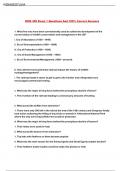AGRADESTUVIA
WCB 305 Exam 1 Questions And 100% Correct Answers
1. What five eras have been conventionally used to outline the development of the
current status of wildlife conservation and management in the US?
i. Era of Abundance (1500—1849)
ii. Era of Overexploitation (1850—1899)
iii. Era of Protection (1900—1929)
iv. Era of Game Management (1930—1965)
v. Era of Environmental Management (1966—present)
b. How did the transcontinental railroad impact the history of wildlife
ecology/management?
i. The railroad made it easier to get to get to the frontier and refrigerated cars
encouraged commercial hunting
c. What was the major driving force behind the precipitous decline of bison?
1. The invention of the railroad leading to unnecessary amounts of hunting
ii. What saved the buffalo from extinction?
1. There were only 300 left in the wild at the end of the 19th century and Congress finally
took action outlawing the killing of any birds or animals in Yellowstone National Park
where the only surviving buffalo herd could be protected
d. What was the major driving force behind the precipitous decline of beaver?
1. Their hides were used for hats
ii. What saved the beavers from extinction?
1. Top hats with feathers on them became popular
e. What was the main reason for the Snowy Egrets and Great Egrets sudden decline?
1. Their feathers and/or bodies would be made into plumes or hats
,AGRADESTUVIA
ii. What finally saved the Egrets from extinction?
1. a negative stigma was put on wearing these plumes because people started caring
about how birds were dying off and being killed just for hats
f. What were the restaurants' roles in the precipitous decline of many species of
wildlife?
i. No one had ever made rules against the killing of animals for the market meat, and
thus birds or deer had been being killed in an unsustainable manner without caution or
thought. Nobody cared where the meat was coming from and what it was doing to the
environment. Luckily now, there are laws about killing certain animals and the transport
of animal parts over borders.
g. What role did utilitarianism and fear play in the history of wildlife management/ history
in the US?
i. This was a belief in America-that the wild had to be tamed-so forests were knocked
down, animals were killed and used because humans could have power over it. There
was also a lot of fear towards the wildlife, too; hence, bears, wolves, sharks, along with
many other predators, were killed trying to protect themselves.
2. What does the Lacey Act prohibit, to what was the original intent of the Act, and what
major coverage was added later?
a. The Lacey Act makes it unlawful to import, export, sell, acquire, or purchase fish,
wildlife or plants that are taken, possessed, transported, or sold: 1) in violation of U.S.
or Indian law, or 2) in interstate or foreign commerce involving any fish, wildlife or plants
taken possessed or sold in violation of State or foreign law.
c. In 2008, the Lacey Act was amended to include a wider variety of prohibited plants
and plant products, including products made from illegally logged woods, for import.
Today it regulates the import of any species protected by international or domestic law
and prevents the spread of invasive, or non-native, species.
S
, AGRADESTUVIA
what was the first federal law protecting wild life
lacey act
3. What does the Migratory Bird Treaty Act prohibit, what was the original intent of the
Act, and in what sense is it a treaty?
Provides strict prohibitions against activities such as hunting, possession, sale,
transportation, and export of migratory birds, except those with specific regulations for
such activities. Protection does not only afford the migratory bird species, but their
nests or eggs. This prohibition is given treaty status by its amendments, which the
United States has signed in coordination with Mexico, Japan, and the former Soviet
Union, now Russia, extending international cooperation on protection regarding
migratory birds.
4. What impact did Teddy Roosevelt have on US wildlife conservation?
a. Teddy Roosevelt Expanded federal protected/public lands, US Forest Service and
National Wildlife Refuge system
What impact does John Muir have on the conservation?
b. John Muir and his advocacy for national parks and Organized NGOs Audubon
Society, Sierra Club- environmental group which fought for environmental laws and
parks). Founding father of national parks. A writer
5. Most of the federal public land is located in what part of the US? How did it get to be
this way?
a. The west because there was the least amount of people there, many of the areas did
not want to be lived in anyways and the east was already too settled and packed with
humans to establish public land by the time they were doing it.




